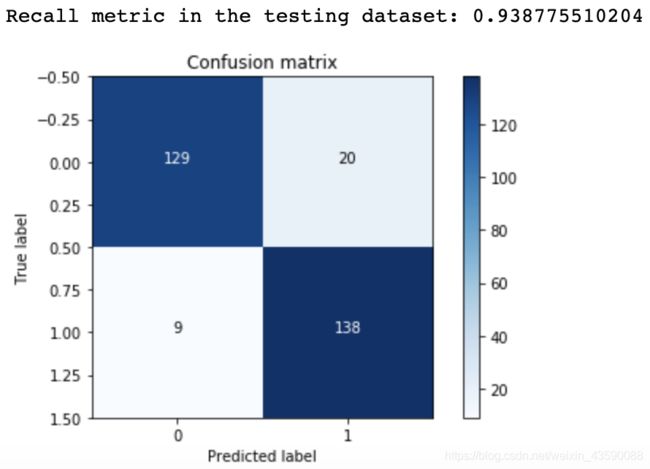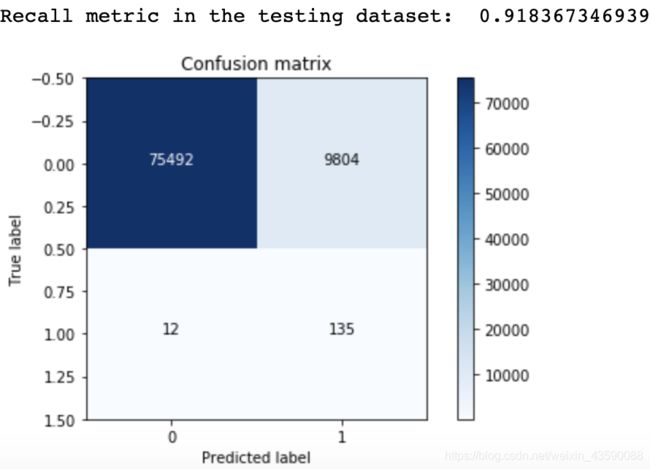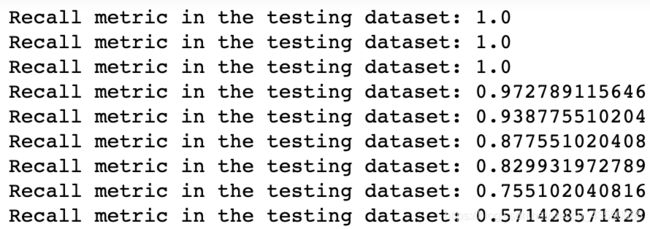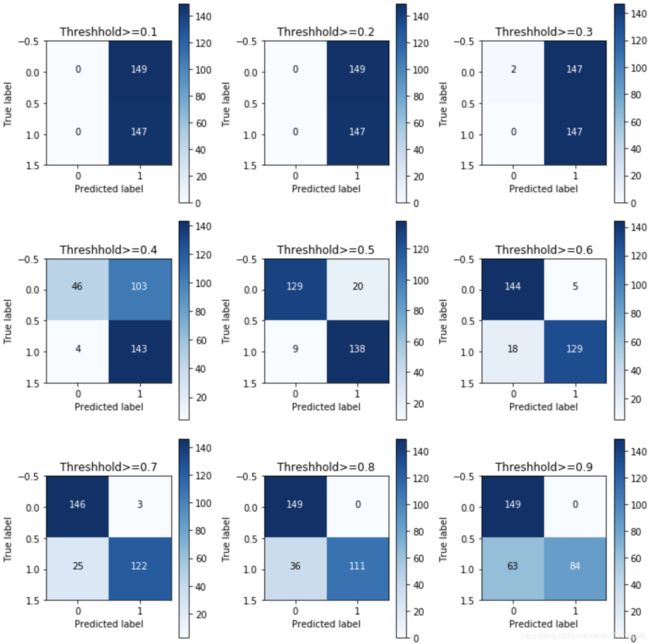机器学习(四):逻辑回归实战——信用卡欺诈检测
文章目录
- 1、数据
- 2、样本不均衡解决方案
- 3、交叉验证
- 4、模型评估方法
- 5、正则化惩罚
- 6、混淆矩阵
- 7、逻辑回归阈值对于结果的影响
- 8、SMOTE算法
1、数据
数据链接在此
https://pan.baidu.com/s/1APgU4cTAaM9zb8_xAIc41Q密码: xgg7
import pandas as pd
import matplotlib.pyplot as plt
import numpy as np
data = pd.read_csv("creditcard.csv")
data.head()
- time表示交易持续的时间;
- v1、v2、v3…v28表示特征;
- Amount表示交易额金额;
- Class 这列0代表是正常样本,1代表异常样本
count_classes = pd.value_counts(data['Class'], sort = True).sort_index() # 对class这列出现的数字进行统计
count_classes.plot(kind = 'bar') # 画条形图
plt.title('Fraud class histogram')
plt.xlabel("Class")
plt.ylabel("Frequency")
2、样本不均衡解决方案
可以看到正常样本0很多,异常样本1非常少,这种样本数据不均衡,可以有两种解决方案。
(1)下采样。将数据变得同样少,可以随机选择0的数据,变得和1的数据一样多。
(2)过采样。将数据变得同样多,对1的样本数据生成数列,让生成的数据与0的样本数据一样多。
首先需要将Amount那一列数据处理成(-1,1)区间的
from sklearn.preprocessing import StandardScaler
# reshape(-1,1)前面的-1可自动识别有几行,第二个1表示一列
data['normAmount'] = StandardScaler().fit_transform(data['Amount'].reshape(-1, 1))
data = data.drop(['Time','Amount'],axis=1)# 丢弃这两列
data.head()
举例:下采样
# ix / loc 可以通过行号和行标签进行索引
X = data.ix[:, data.columns != 'Class']# 前面的“:”表示所有行,后面表示列名不为Class的所有列
y = data.ix[:, data.columns == 'Class']
#class为1的有多少个
number_records_fraud = len(data[data.Class == 1])
fraud_indices = np.array(data[data.Class == 1].index)
normal_indices = data[data.Class == 0].index
# 随机选择和class为1的个数相同的class为0的行
random_normal_indices = np.random.choice(normal_indices,number_records_fraud,replace=False)
random_normal_indices = np.array(random_normal_indices)
# 合并数据
under_sample_indices = np.concatenate([fraud_indices,random_normal_indices])
under_sample_data = data.iloc[under_sample_indices,:]
X_undersample = under_sample_data.ix[:,under_sample_data.columns != 'Class']
y_undersample = under_sample_data.ix[:,under_sample_data.columns == 'Class']
print("Percentage of normal transactions: ", len(under_sample_data[under_sample_data.Class == 0])/len(under_sample_data))
print("Percentage of fraud transactions: ", len(under_sample_data[under_sample_data.Class == 1])/len(under_sample_data))
print("Total number of transactions in resampled data: ", len(under_sample_data))
输出结果:
Percentage of normal transactions: 0.5
Percentage of fraud transactions: 0.5
Total number of transactions in resampled data: 984
3、交叉验证
它的主体思想是将原始数据进行分组,一部分作为训练集,一部分作为验证集。利用训练集训练出模型,利用验证集来测试模型,以评估分类模型的性能。
K折交叉验证:这里的k折是把数据分为k组,将k-1组作为训练集训练出一个模型,然后将剩下的一组用做测试集。
举例子:将源数据切分为了1、2、3三个数据集
- 第一次:数据集1,2作为训练集,3作为测试集
- 第二次:数据集1,3作为训练集,3作为测试集
- 第三次:数据集2,3作为训练集,3作为测试集
最后求均值
from sklearn.cross_validation import train_test_split
# sklearn.cross_validation是交叉验证模块,train_test_split对原始数据集进行切分
# 整个原始数据集,test_size=0.3表示把30%的数据作为测试集
X_train, X_test, y_train, y_test = train_test_split(X,y,test_size=0.3, random_state = 0)
print("Number transactions train dataset: ", len(X_train))
print("Number transactions test dataset: ", len(X_test))
print("Total number of transactions: ", len(X_train)+len(X_test))
# 下采样的数据
X_train_undersample, X_test_undersample, y_train_undersample, y_test_undersample = train_test_split(X_undersample ,y_undersample ,test_size = 0. ,random_state = 0)
print("")
print("Number transactions train dataset: ", len(X_train_undersample))
print("Number transactions test dataset: ", len(X_test_undersample))
print("Total number of transactions: ", len(X_train_undersample)+len(X_test_undersample))
输出:
Number transactions train dataset: 199364
Number transactions test dataset: 85443
Total number of transactions: 284807
Number transactions train dataset: 688
Number transactions test dataset: 296
Total number of transactions: 984
4、模型评估方法
假设有1000个病人的数据,要对1000个病人进行分类,有哪些是癌症的?哪些不是患有癌症的?假设其中有990个人不患癌症,10个人是患癌症。
(1)将1000个样本输入到模型中,精度=990/1000=99%
(2)召回率recall:表示根据目标制定衡量的标准,在一个只有10人的样本里,查到2个人患癌症,那召回率为0.2

5、正则化惩罚
比如有两个训练模型,A模型:ø1、ø2、ø3…ø10,B模型:ø1、ø2、ø3…ø10,这两个模型的recall值都是等于90%。A模型的原点浮动比较大,呈波浪形,B模型的原点浮动比较小。
一般都希望得到B模型这样的,之后在测试集上训练使得过度拟合(过度拟合的意思是在训练集表达效果很好,但是在测试集表达效果很差)的风险更小。从而引入正则化,惩罚模型的ø,大力度惩罚A模型,小力度惩罚B模型。
(1)L2正则化
惩罚:损失函数+1/2w*w
对于A模型,w值浮动大,计算出来的值就大
(2)L1正则化
惩罚:损失函数+|w|
可以设置当前惩罚力度有多大,比如0.1倍的L2正则化
#Recall = TP/(TP+FN)
from sklearn.linear_model import LogisticRegression
from sklearn.cross_validation import KFold, cross_val_score
from sklearn.metrics import confusion_matrix,recall_score,classification_report
# 这里的KFold是指交叉验证的时候,可以选择做几倍的交叉验证; cross_val_score值是指交叉验证评估得到的结果
def printing_Kfold_scores(x_train_data,y_train_data):
# 将数据集切分为5份
fold = KFold(len(y_train_data),5,shuffle=False)
# 正则惩罚力度
c_param_range = [0.01, 0.1, 1, 10, 100]
results_table = pd.DataFrame(index = range(len(c_param_range),2), columns = ['C_parameter','Mean recall score'])
results_table['C_parameter'] = c_param_range
j=0
# 找到最好的一个c参数
for c_param in c_param_range:
print('-------------------------------------------')
print('C parameter: ', c_param)
print('-------------------------------------------')
print('')
recall_accs = []
for iteration, indices in enumerate(fold,start=1):
# 传入C这个惩罚力度,方式可选l1或则l2
lr = LogisticRegression(C=c_param,penalty = 'l1')
# 对模型进行训练
lr.fit(x_train_data.iloc[indices[0],:],y_train_data.iloc[indices[0],:].values.ravel())
# 预测
y_pred_undersample = lr.predict(x_train_data.iloc[indices[1],:].values)
recall_acc = recall_score(y_train_data.iloc[indices[1],:].values,y_pred_undersample)
recall_accs.append(recall_acc)
print('Iteration', iteration,': recall score = ',recall_acc)
results_table.ix[j,'Mean recall score']=np.mean(recall_accs)
j += 1
print('')
print('Mean recall score ', np.mean(recall_accs))
print('')
best_c = results_table.loc[results_table['Mean recall score'].idxmax()]['C_parameter']
# Finally, we can check which C parameter is the best amongst the chosen.
print('*********************************************************************************')
print('Best model to choose from cross validation is with C parameter = ', best_c)
print('*********************************************************************************')
return best_c
best_c = printing_Kfold_scores(X_train_undersample,y_train_undersample)
-------------------------------------------
C parameter: 0.01
-------------------------------------------
Iteration 1 : recall score = 0.958904109589
Iteration 2 : recall score = 0.931506849315
Iteration 3 : recall score = 1.0
Iteration 4 : recall score = 0.972972972973
Iteration 5 : recall score = 0.954545454545
Mean recall score 0.963585877285
-------------------------------------------
C parameter: 0.1
-------------------------------------------
Iteration 1 : recall score = 0.835616438356
Iteration 2 : recall score = 0.86301369863
Iteration 3 : recall score = 0.966101694915
Iteration 4 : recall score = 0.945945945946
Iteration 5 : recall score = 0.909090909091
Mean recall score 0.903953737388
-------------------------------------------
C parameter: 1
-------------------------------------------
Iteration 1 : recall score = 0.849315068493
Iteration 2 : recall score = 0.86301369863
Iteration 3 : recall score = 0.983050847458
Iteration 4 : recall score = 0.945945945946
Iteration 5 : recall score = 0.909090909091
Mean recall score 0.910083293924
-------------------------------------------
C parameter: 10
-------------------------------------------
Iteration 1 : recall score = 0.86301369863
Iteration 2 : recall score = 0.890410958904
Iteration 3 : recall score = 0.983050847458
Iteration 4 : recall score = 0.945945945946
Iteration 5 : recall score = 0.924242424242
Mean recall score 0.921332775036
-------------------------------------------
C parameter: 100
-------------------------------------------
Iteration 1 : recall score = 0.86301369863
通过结果可以看出,当惩罚参数是0.01,recall的值最高.
6、混淆矩阵
混淆矩阵是由一个坐标系组成的,有x轴以及y轴,在x轴里面有0和1,在y轴里面有0和1.x轴表达的是预测的值,y轴表达的是真实的值。
def plot_confusion_matrix(cm, classes,
title='Confusion matrix',
cmap=plt.cm.Blues):
plt.imshow(cm, interpolation='nearest', cmap=cmap)
plt.title(title)
plt.colorbar()
tick_marks = np.arange(len(classes))
plt.xticks(tick_marks, classes, rotation=0)
# plt.yticks(tick_marks, classes)
thresh = cm.max() / 2.
for i,j in itertools.product(range(cm.shape[0]),range(cm.shape[1])):
plt.text(j,i,cm[i,j],
horizontalalignment="center",
color="white" if cm[i, j]>thresh else "black")
plt.tight_layout()
plt.ylabel('True label')
plt.xlabel('Predicted label')
import itertools
lr = LogisticRegression(C = best_c,penalty = 'l1')
lr.fit(X_train_undersample, y_train_undersample.values.ravel())
y_pred_undersample = lr.predict(X_test_undersample.values)
# 计算混淆矩阵
cnf_matrix = confusion_matrix(y_test_undersample,y_pred_undersample)
np.set_printoptions(precision=2)
print("Recall metric in the testing dataset:", cnf_matrix[1,1]/(cnf_matrix[1,0]+cnf_matrix[1,1]))
# 画图
class_names = [0,1]
plt.figure()
plot_confusion_matrix(cnf_matrix,
classes=class_names,
title='Confusion matrix')
plt.show()
输出结果:

真实为1,预测为1,得到结果是137;真实为1,预测为0,得到结果是10,计算召回率为recall=138/(138+9)
真实为1,预测为1,得到结果是137;真实为0,预测为0,得到结果是129,计算精度为(129+138)/(129+20+9+138)
以上是在下采样数据集上进行的测试,样本只有200多个,所以还需要在原始数据集上进行操作。
lr = LogisticRegression(C = best_c, penalty = 'l1')
lr.fit(X_train_undersample,y_train_undersample.values.ravel())
y_pred = lr.predict(X_test.values)
# 采用原始数据集
cnf_matrix = confusion_matrix(y_test,y_pred)
np.set_printoptions(precision=2)
print("Recall metric in the testing dataset: ", cnf_matrix[1,1]/(cnf_matrix[1,0]+cnf_matrix[1,1]))
# 画图
class_names = [0,1]
plt.figure()
plot_confusion_matrix(cnf_matrix
, classes=class_names
, title='Confusion matrix')
plt.show()
输出:

由图可知,召回率的值变化不大,能够达到标准,但是精度值变化很大,找出的9804个无辜样本很影响精度值。
7、逻辑回归阈值对于结果的影响
自定义阈值,研究不同阈值对结果的影响。
lr = LogisticRegression(C = 0.01, penalty='l1')
lr.fit(X_train_undersample, y_train_undersample.values.ravel())
y_pred_undersample_proba = lr.predict_proba(X_test_undersample.values)
threshholds = [0.1, 0.2, 0.3, 0.4, 0.5, 0.6, 0.7, 0.8, 0.9]
plt.figure(figsize=(10,10))
j=1
for i in threshholds:
y_test_predictions_high_recall = y_pred_undersample_proba[:,1] > i
plt.subplot(3,3,j)
j+=1
#计算混淆矩阵
cnf_matrix = confusion_matrix(y_test_undersample,y_test_predictions_high_recall)
np.set_printoptions(precision=2)
print("Recall metric in the testing dataset:", cnf_matrix[1,1]/(cnf_matrix[1,0]+cnf_matrix[1,1]))
class_names = [0,1]
plot_confusion_matrix(cnf_matrix
,classes=class_names
,title='Threshhold>=%s'%i)
结果如下:


由图可见,阈值越大,误杀值越小,精度变高,但是召回率变小。
8、SMOTE算法
以上操作都是下采样,主要用于模型回归的评估以及参数的选择,下面主要介绍过采样,比如是将100个样本扩展为500个样本。
(1)SMOTE算法
举例:要将一个样本变为5个样本,首先计算它与相邻的5个样本之间的距离,于是新值等于原始值加上距离乘以随机数。
(2)代码实现
需要安装imblearn这个包,遇到问题,在当前的channels中找不到这个包,解决方案http://wenda.chinahadoop.cn/question/6764
import pandas as pd
from imblearn.over_sampling import SMOTE
from sklearn.ensemble import RandomForestClassifier
from sklearn.metrics import confusion_matrix
from sklearn.model_selection import train_test_split
credit_cards = pd.read_csv('creditcard.csv')
columns = credit_cards.columns
# 删去class那一列
features_columns = columns.delete(len(columns)-1)
features=credit_cards[features_columns]
labels=credit_cards['Class']
features_train, features_test,labels_train, labels_test = train_test_split(features,
labels,
test_size=0.2,
random_state=0)
# 用SMOTE进行数据生成,首先实例化一个对象,叫oversampler,SMOTE可以不使用参数,但是要使每次生成的数据都是一样的,可以random_state=0.
oversampler = SMOTE(random_state=0)
it_sample(features_train,labels_train)传进来的是训练集的x以及训练集的y
os_features, os_labels = oversampler.fit_sample(features_train,labels_train)
# 这里是计算lable1的有多少个
len(os_labels[os_labels==1])
结果如下:
共有227454个.lable0的也有20多万个,因此样本就均衡了
227454
可以看召回率是多少
os_features = pd.DataFrame(os_features)
os_labels = pd.DataFrame(os_labels)
best_c = printing_Kfold_scores(os_features,os_labels)
结果如下:
-------------------------------------------
C parameter: 0.01
-------------------------------------------
Iteration 1 : recall score = 0.890322580645
Iteration 2 : recall score = 0.894736842105
Iteration 3 : recall score = 0.968861347792
Iteration 4 : recall score = 0.957111924468
Iteration 5 : recall score = 0.958419889867
Mean recall score 0.933890516976
-------------------------------------------
C parameter: 0.1
-------------------------------------------
Iteration 1 : recall score = 0.890322580645
Iteration 2 : recall score = 0.894736842105
Iteration 3 : recall score = 0.970410534469
Iteration 4 : recall score = 0.960156516196
Iteration 5 : recall score = 0.959178289973
Mean recall score 0.934960952678
-------------------------------------------
C parameter: 1
-------------------------------------------
Iteration 1 : recall score = 0.890322580645
Iteration 2 : recall score = 0.894736842105
Iteration 3 : recall score = 0.970543321899
Iteration 4 : recall score = 0.960321385784
Iteration 5 : recall score = 0.960541211901
Mean recall score 0.935293068467
-------------------------------------------
C parameter: 10
-------------------------------------------
Iteration 1 : recall score = 0.890322580645
Iteration 2 : recall score = 0.894736842105
Iteration 3 : recall score = 0.970432665708
Iteration 4 : recall score = 0.959628933514
Iteration 5 : recall score = 0.960815994548
Mean recall score 0.935187403304
-------------------------------------------
C parameter: 100
-------------------------------------------
Iteration 1 : recall score = 0.890322580645
Iteration 2 : recall score = 0.894736842105
Iteration 3 : recall score = 0.970499059422
Iteration 4 : recall score = 0.960321385784
Iteration 5 : recall score = 0.95657335048
Mean recall score 0.934490643687
*********************************************************************************
Best model to choose from cross validation is with C parameter = 1.0
*********************************************************************************
通过以上的结果可以知道recall值平均算下来大概是0.934
混淆矩阵
lr = LogisticRegression(C = best_c, penalty = 'l1')
lr.fit(os_features,os_labels.values.ravel())
y_pred = lr.predict(features_test.values)
# Compute confusion matrix
cnf_matrix = confusion_matrix(labels_test,y_pred)
np.set_printoptions(precision=2)
print("Recall metric in the testing dataset: ", cnf_matrix[1,1]/(cnf_matrix[1,0]+cnf_matrix[1,1]))
# Plot non-normalized confusion matrix
class_names = [0,1]
plt.figure()
plot_confusion_matrix(cnf_matrix
, classes=class_names
, title='Confusion matrix')
plt.show()
结果:

由图可知,误杀值为517,比使用下采样的误杀值少很多,精度提高,但是召回率偏低。
总结:对于样本不均衡数据,要利用越多的数据越好,下采样误杀率很高,这是模型本身自带的一个问题。因为0和1一样少,会存在潜在的意识是原始数据0和1的数据一样少,导致误杀率偏高.过采样的结果偏好一些,虽然recall偏低了一点,但是整体的效果还是不错的。
参考:https://www.jianshu.com/p/ad394fecedbf

